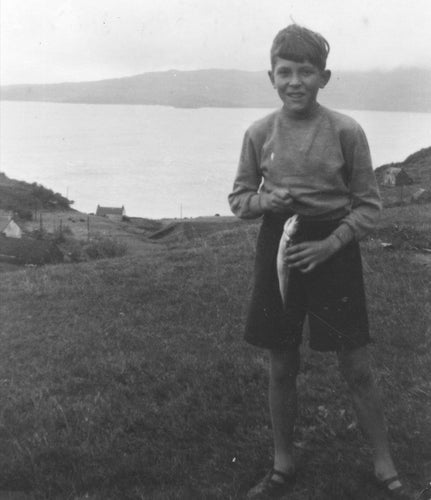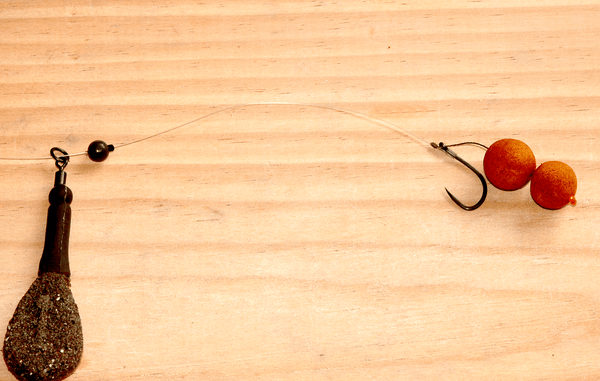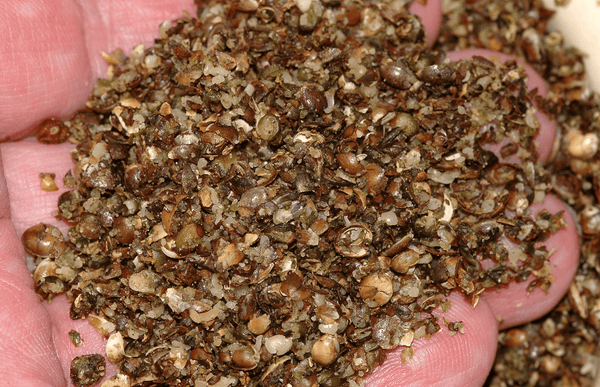
Carp Bait
Share

But lets go back to the beginning. This was the first fish I ever caught. I guess I am about six or seven years old in this photo but that fish triggered a passion for angling. Little did I know that this passion would lead to a life spent in fishing in one way or another.

I started fishing at a very early age under the watchful eye of my Grandpa, a pretty inept teacher if the truth be told. However I will always be grateful to him for igniting the spark that turned me into an angler. That's me on the right in the inadequate rain gear fishing with Grandpa on a wild and windswept Scottish loch. Did I catch anything? Nah!

I drifted into carping rather by accident. We got married in 1968 and even though my angling had taken a bit of a back street, by chance we set up home in the English county of Surrey. At the time carp fishing was in its first flush of youth, nothing like the adult pastime it has become today, but the Home Counties were seeing the first tentative steps towards modern carp fishing. However, even going out for a pint somehow inadvertently nudged me into rediscovering the long lost joys of angling from my youth.

As luck would have it our first home was situated not far from a fairly well known carp lake, Cutt Mill, which was just over the Hogs Back from our new flat. Bait at that time was either potato or floating crust. The crust was fished either free lined or fixed to the lakebed using a small lead. The method was called the Upside Down Crust Rig and it was the first rig I ever used to catch carp on purpose. This is from about 1968…God! I wish I were that slim again!
Then in 1971 we moved down to Fowey and I started work on a commercial fishing boat and carp fishing was shoved aside for several years. At weekends we took out parties to fish the wrecks and one of our regular groups was a bunch of mates I used to fish with in Surrey. Their chat about the goings on in the carp world “up country” rekindled my interest in carping and in 1977 my mate Bill got me into the Ockenham Lakes Syndicate in Devon run by Peter Mohan. It was here that I first came to terms with proper boiled baits, and also got into particle bait fishing, Rod Hutchinson’s articles in Angling magazine having sparked my interest. My mates called the trips down west "wrecking with the hippy guy"!

Then in 1978 Bill came down to join me on the Lakes with a couple of very interesting “secrets” up his sleeve, secrets that he very decently shared with me,. These were the original hair rig and the Robin Red boiled bait. Bill had been fishing at Cut Mill when one of the regulars took him into his confidence and showed him the hair rig. Bill also discovered Robin Red at the Surrey lake. His generosity marked the turning point in my life. Carp fishing would never be the same again!

Naturally, using these two 'secrets' I enjoyed phenomenal fishing wherever I took this deadly combination. I used the two secrets back home in Cornwall and I am 100% certain I was the only carp angler in the county that knew about both the rig and Robin Red. I started fishing a new lake, one of Roche AC's venues called Wheal Rashleigh and the first time I use the Robin Red boiled bait on the hair rig I caught the lake's biggest mirror and the biggest common on a short day session!

Clearly the combo was working well and though the bait was nothing special by modern standards it was pretty special by the standards of the day. The recipe was eight ounces of fine-ground Nectarblend and two of Robin Red, and four ounces of muscovado sugar, the latter being dissolved in hot water before being added to the eggs. The bait was flavoured Kemp's Perfume Spray, an attractor that Bill had been using up-country. I was later informed that the flavour contained the essential oil of geranium, which was what set the bait apart. Certainly the Cornish record mirror of the day took a big liking to the bait: I caught Big Daddy on it on my first trip to Salamander Lake with the new bait and rig.

It looked as if I could catch carp almost to order using the Nectarblend/Robin Red boilie fished on the hair; I thought this carp fishing lark was supposed to be difficult! Of course, though I didn't realise it at the time, the bait had a lot to do with my success but I realised that it would not go on catching forever. That said Robin Red has proved to have an almost indefinite catching life and baits containing the red stuff have been an astonishing success for Haith's users as it is used in countless baits the length and breadth of Europe. These are Robin Red 'Chops'.

You make the chops by first rolling out your paste into sausages, which are then boiled whole for 3 minutes. Remove the boiled sausages from the pan and put them on a clean towel to dry and harden. Once dry cut the sausages into chops of your preferred size.

Chops have a major advantage over standard, round boiled baits. They have two open sides that have not been affected by the heat process creating a very porous bait that will readily soak up liquid foods, or other liquid attractors such as diluted flavours, seafood extracts or even good old vinegar. If chops have a drawback it is that they are not particularly aerodynamic so they don't go far out of a catapult or throwing stick. However, for margin fishing or if using a boat or bait boat they are the perfect boiled bait in my opinion. In fact chops are my go-to baits whenever I am not governed by the need to fish at longer ranges.

When modern boiled baits were first being developed the very first specialised base mixes were all formed using ingredients primarily intended for feeding cage and wild birds. These soon came to be known as birdfood mixes and today, many years later, they are still one of the most popular carp baits in current use, as they are usually comparatively cheap, highly digestible and very attractive to carp. In the early days many of us used a mix that would be regarded as rather crude today.
7oz Red Factor or Nectarblend (fine ground)
2oz Wheat Gluten
1oz Robin Red
10 ml Maple flavour
2g sweetener powder.
This photo dates from about 1982, a fish going back into my local park lake.

Way back when birdfood boiled baits were first used they relied on the high attract principle to catch. The trouble was this meant using very high levels of acidic attractors. As is usually the case when high levels of flavour are used, carp in time become repelled by the excess rather than be attracted by it. Birdfood baits soon became less effective as carp began to avoid the excessive flavour levels. A more enlightened attitude prevails these days and flavour levels are now used at much lower levels. John Baker's Plum for instance has a recommended level of just 1-2ml per 500g of base mix.

This more balanced food source can be made even more attractive by using flavours and other additives at lower levels. This has the effect of turning a LNV (low nutritional value) base mix into a bait with a viable long-term nutritional value food bait. Birdfood baits are usually almost instant with no need for extensive pre-baiting campaigns. Provided the flavour and attractor levels have been sensibly applied there is no reason why a well-made birdfood bait will not last several seasons. A common trend when using birdfood baits is that the more bait you put in the better your results.

Big fish are big because they know a good bait when they taste one! If the carp is fit and healthy it will gain weight on such a diet and as you can see from this photo of a sixty in the sling, given the right conditions and a diet of top quality bait, carp can grow huge.

I guess that nowadays, with a large number of bait companies all striving for their slice of the market, birdfoods must be one of the most cost-effective of their products. There must be a hundred and one different birdfood base mixes around these days, all claiming to empty lakes and put you and you alone out in front. But as we have already seen there are only so many birdfoods around and just about every mix will contain a percentage of one or more of the same ingredients. Some of the best birdfoods come from the UK company Haith’s and the legendary Robin Red is arguably "the most popular bait ingredient in the world" as Mr Clarkson might put it.

Birdfoods are not generally thought of as high protein but you can create a powerful HNV bait using a birdfood base mix with added pre-digested protein such as CPSP90, a hydrolysed fish protein.

This base mix, Big Seed Mix, was one of the first pre-blended birdfood base mixes. It was commercially marketed by Bill Cottam's Nutrabaits company way back in the late 80s and it was popularised by Julian Cundiff. Jules used it more or less unchanged for several seasons and it brought him considerable success. Look at the Haith's original ingredients on the list. These have been long-established favourites with birdy mix fans for decades.

A few birdfoods are based upon crushed seeds such as crushed hemp (as seen in this photo). Others contain ground pulses or whole seeds such as Niger Seed (aka Thistle Seed). As their name implies, birdfoods are designed to improve and maintain the condition of show birds such as parakeets, canaries and budgies. Crushed hempseed (see photo) is a great ingredient to use in groundbaits. Its structure creates a wealth of hemp particles with varying buoyancies. Some bits sink, others float while others have a neutral buoyancy. You can imagine the groundbait carpet as the bait breaks down! All that hemp attraction drifting up and down over the bait carpet! Enticing or what!

Another excellent ingredient around which to build a base mix is Red Factor. This is a top quality birdfood that is highly attractive, readily digestible, comparatively cheap, and if used with high quality fishmeals, or milk or egg proteins will make a very good long term bait. The coarse nature of most birdfoods allows an almost immediate water exchange once the bait is in the lake: water goes in, flavour and attraction comes out. This is the recipe for a good base mix.
250g Red Factor
200g semolina
50g Robin Red
1 - 2ml John Baker's Plum flavour.
20 - 30ml Sanchi Tamari Soy Sauce.

Another great ingredient is Red Band Pigeon Conditioner. I like to use it both whole or ground down. In fact, one of the earliest birdfood boilies was simply 8oz each finely ground Red Band and 8oz ground Nectarblend. (While we are on the subject let my point out that it also makes a fantastic micro seed bait. Simply soak the Red Band overnight and then boil it for 15-20 minutes. Look at all that carpy attraction!)

In my opinion, the key to the success of most birdfoods is their relatively high fat content. In fact some bait companies actually term a birdfood` bait as "High Energy". All birdfoods involve a source of fat; often a food oil of some kind and it is the fat aspect of most birdfoods that makes them so useful as carp bait additives. Fat is a vital component of a carp's diet as it has a sparing effect on protein. This pure Salmon Oil is superb; carp adore it.

Fish oil can also be used to add extra pulling power to your bait carpet. Try glugging your Robin Red chops in it! While oil is insoluble in water carp can detect its presence in the bait as they eat it. Tiny oil-bound particles of the bait will inevitably escape from the gills as the bait is crushed in the throat teeth and these will drift in the water table attracting passing carp..

You can also add soluble liquids to your bait in the form of Oceanic extracts, yeast extracts and hydrolysed liquid proteins, examples of which are shown here.

Some anglers, those that don't care one jot about the science behind carp bait, say that knowing the ins and outs of the bait world is not important. I would simply say, yes, that may be true, but it's a fascinating subject and there is so much still to learn. You never know, the next breakthrough might be down to you. After all, there is still plenty of room for experiment in the field of carp bait technology so why not dig a bit deeper to find out what makes a bait tick. Carp bait, as a whole is an enthralling subject that constantly makes demands on the enthusiast. The more we know, the more we need to know more! Compared to some I am doing nothing more than groping in the dark, but I always did like a good grope, and to quote Sir Issac Newton FRS, "if I have seen further it is by standing on the shoulders of Giants", so big thanks to the giants of bait science.
Written by Ken Townley
